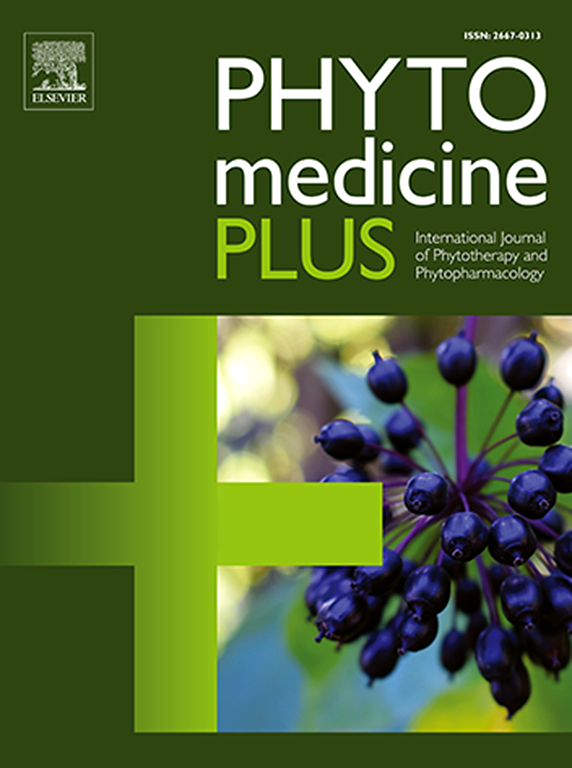等螺杆菌镇痛电位的测定及阿片和GABA受体的分子参与
Q3 Pharmacology, Toxicology and Pharmaceutics
引用次数: 0
摘要
草药被用作治疗剂的来源,因为它们比合成药物更安全,毒性更小。在民间医学中,已经有文献记载了几种具有镇痛作用的蛇尾草。本研究旨在探讨等宽螺旋肌可能的镇痛潜能。采用乙酸致扭体模型、福尔马林舔爪试验和浸尾试验等不同疼痛模型,对亚麻仁粗提物(Hi-Crd)及其亚组分、乙酸乙酯(Hi-Et)和氯仿(Hi-Chl)进行研究。醋酸致扭体模型大鼠扭体次数明显减少。粗提物和氯仿馏分与标准馏分相比更有效。阴性对照组扭体次数为76.56±1.21次,300 mg/kg剂量组Hi-Crd和75 mg/kg剂量组Hi-Chl扭体次数为20.18±2.03次(P <;0.001)和17.74±2.39 (P <;分别为0.001)。在福尔马林舔爪模型中,粗提物300 mg/kg b.w的舔爪反应为20.09±1.45 (P <;0.001),活性百分比分别为49.85%和17.22±1.33 (P <;0.001),活性百分比为72.15%。75 mg/kg b.w剂量的Hi-Chl的舔舐反应为19.55±1.76 (P <;0.001),活性百分比分别为51.19%和16.01±2.21 (P <;0.001),活性百分比为74.11%。通过尾浸试验测定中枢镇痛电位,其中Hi-Chl组分最有效,传递百分率为71.64%。标准曲马多在10 mg/kg剂量下的活度为82.29%。由于阿片受体的参与,纳洛酮以2 mg/kg的剂量与标准和测试样品共同给药,纳洛酮完全拮抗曲马多。纳洛酮完全逆转了Hi-Crd、Hi-Chl和Hi-Et的镇痛作用,这证实了阿片受体参与了提取物的镇痛作用。对于gaba能系统的参与,在与测试样品一起处理之前注射双球茎碱。在没有和有二胡碱的情况下,扭曲部分逆转,证明gaba能系统参与了粗提取物和馏分的镇痛作用。本文章由计算机程序翻译,如有差异,请以英文原文为准。
Determination of analgesic potential of Helicteres isora and molecular involvement of opioids and GABA receptors
Herbal medicines are used as a source of therapeutic agents as they are safer and less toxic than synthetic drugs. Several species of Helicteres isora (Sterculiaceae) have been documented in folk medicine to have analgesic properties. This study is aimed to explore possible analgesic potential of Helicteres isora. linn crude extracts (Hi-Crd) and its sub-fractions, ethyl acetate (Hi-Et) and chloroform (Hi-Chl) by using various models for pain such as acetic acid induced writhing model, formalin paw licking test and tail immersion test. A significant decrease was seen in the frequency of writhing in acetic acid-induced writhing model. The crude extracts and chloroform fractions were more effective when compared to standard. The negative control group displayed a writhing frequency of 76.56 ± 1.21, Hi-Crd at dose of 300 mg/kg and Hi-Chl at dose of 75 mg/kg produces writhing of 20.18 ± 2.03 (P < 0.001) and 17.74 ± 2.39 (P < 0.001) respectively. In formalin paw licking model Crude extract at a dose of 300 mg/kg b.w produced licking response of 20.09 ± 1.45 (P < 0.001) in Phase-I with percentage activity of 49.85% and 17.22 ± 1.33 (P < 0.001) in Phase-II with percentage activity of 72.15 %. Hi-Chl at a dose of 75 mg/kg b.w produced licking response of 19.55 ± 1.76 (P < 0.001) in Phase-I with percentage activity of 51.19 % and 16.01 ± 2.21 (P < 0.001) in Phase-II with percentage activity of 74.11 %. The central analgesic potential was determined by tail immersion test in which the Hi-Chl fraction was most potent and delivered percentage activity of 71.64 %. The standard tramadol delivered percentage activity of 82.29 % at a dose of 10 mg/kg. For the involvement of opioid receptors naloxone was co-administered with standard and test sample at a dose of 2 mg/kg, naloxone completely antagonized tramadol. The analgesic effects of Hi-Crd, Hi-Chl and Hi-Et were completely reversed by naloxone, this confirms involvement of opioids receptors in the analgesic effect of the extracts. For the involvement of GABAergic system bicuculline was injected prior to treatment with test samples. The writhing in the absence and in the presence of bicuculline were partially reversed and the involvement of GABAergic system in the analgesic effect of the crude extracts and fractions is testified.
求助全文
通过发布文献求助,成功后即可免费获取论文全文。
去求助
来源期刊

Phytomedicine Plus
Medicine-Complementary and Alternative Medicine
CiteScore
3.70
自引率
0.00%
发文量
178
审稿时长
81 days
期刊介绍:
 求助内容:
求助内容: 应助结果提醒方式:
应助结果提醒方式:


